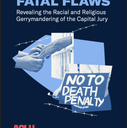Professor Ray Paternoster of the Department of Criminology and Criminal Justice at the University of Maryland was the senior author of a 2003 state-commissioned review of the role that race and geography play in Maryland’s death penalty practice. He recently wrote about the study’s findings in the Baltimore Sun:
I headed the Maryland research team that studied the fairness of the administration of the death penalty in the state. We concluded that race and geography were factors in the decisions that lead to death row. Put another way, whom you kill and where in Maryland you commit the crime make a difference.We concluded this by sifting data on all 1,311 cases between 1978 and 1999 in which prosecutors could have pursued a death sentence. The question was not just who ended up on death row but who did not and what differentiated these two groups.
…
After taking all these other factors into account, we found evidence that race mattered. We found even stronger evidence that the particular jurisdiction where the crime occurred mattered.
…We found that both the race of the victim and, to a lesser extent, the race of the offender, make a difference:
- Those who killed a white victim in Maryland were between two and three times more likely to be sentenced to death than those who killed a non-white.
- Black offenders who killed white victims were nearly 2 1/2 times more likely to be sentenced to death than white offenders who killed white victims and nearly 3 1/2 times more likely to be sentenced to death than black offenders who killed black victims.
We found that these racial differences showed up early in the process, well before the case ever reached a courtroom, in the decisions made by the state’s attorneys on whether to seek a death sentence. Further, these patterns held regardless of jurisdiction.
…
Whatever the reason, the data are clear and the relationships strong: the 21-year record of capital homicide prosecutions suggests that race and geography do play a role in prosecutors’ decisions to pursue a death sentence in the state of Maryland.
…
We consider these findings disturbing. Maryland law spells out a series of aggravating and mitigating factors that alone are supposed to determine whether a convicted murderer gets a death sentence or life in prison. But our study indicated that race and jurisdiction also play a role, affecting cases long before juries ever get to vote — when prosecutors decide whether to pursue a death sentence.
(“Misunderstandings Cloud Death Penatly Findings,” Baltimore Sun, Dec. 20, 2005). See also Race.



